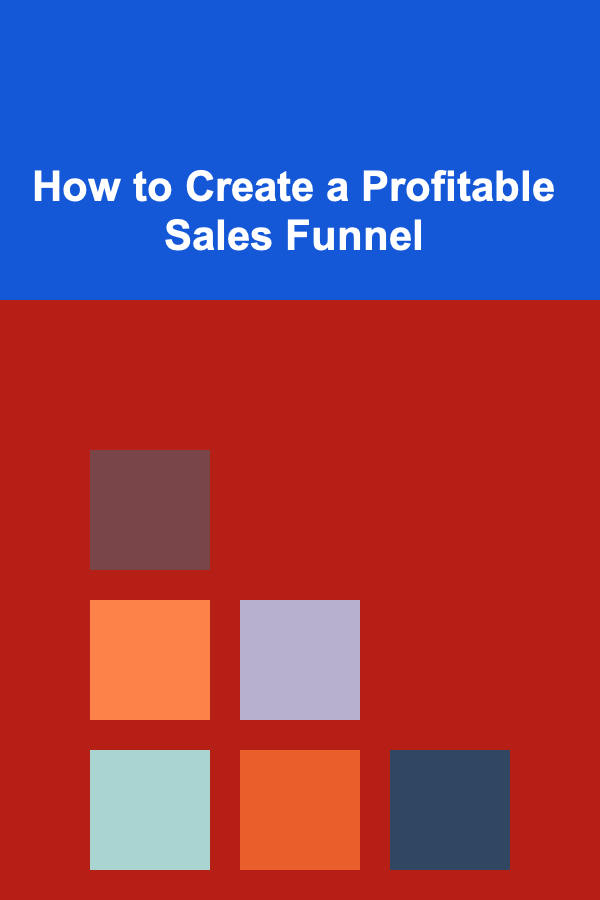
How to Create a Profitable Sales Funnel
ebook include PDF & Audio bundle (Micro Guide)
$12.99$8.99
Limited Time Offer! Order within the next:

In today's digital landscape, a well-constructed sales funnel can be the key to converting potential customers into paying clients and driving long-term business success. A sales funnel is a strategic framework that helps guide prospects through their journey with your brand, from initial awareness to final purchase. The goal is not just to generate leads but to create a systematic process that maximizes revenue and minimizes wasted effort.
This article explores how to build a profitable sales funnel that works for your business, considering everything from funnel stages and customer psychology to tools and strategies for conversion optimization. Let's dive into the process step-by-step to create a sales funnel that consistently brings in profits.
Understanding the Sales Funnel Concept
A sales funnel is typically represented as a wide opening at the top (where prospects first encounter your brand) and narrows down through various stages until it reaches the bottom (where leads are converted into paying customers). Each stage represents a different point in the buyer's journey, and your goal is to provide the right content and offers at each stage to guide them through the funnel.
Here's an overview of the typical stages in a sales funnel:
- Awareness -- At the top of the funnel, prospects first learn about your brand.
- Interest -- Leads begin to show interest in what you offer and engage with your content.
- Decision -- Prospects consider your product or service as a potential solution and evaluate their options.
- Action -- The final stage where the lead takes action, such as making a purchase or signing up for your service.
Understanding these stages is crucial because it helps you design a sales funnel that matches the needs and behavior of your prospects at each phase. The idea is to nurture your leads through the funnel using relevant content, calls to action, and offers that resonate with them.
Building a Profitable Sales Funnel
Now, let's break down the process of creating a profitable sales funnel, starting from defining your target audience to optimizing your funnel for maximum conversions.
1. Define Your Ideal Customer
The first step in creating an effective sales funnel is identifying your target audience. Who are your ideal customers? What are their pain points, desires, and motivations? Without a clear understanding of your target audience, it will be nearly impossible to design a sales funnel that speaks to their specific needs.
To define your ideal customer, start by gathering data from existing customers, market research, and competitor analysis. You can also use customer personas to give your target audience a human touch. Create detailed profiles that describe their demographics, goals, challenges, and purchasing behaviors. This will help you tailor your sales funnel to meet their unique preferences.
2. Drive Awareness Through Content Marketing
The awareness stage of the funnel is where you capture the attention of potential customers. At this stage, prospects may not know about your brand, but they are likely searching for solutions to problems related to your product or service.
To create awareness, content marketing is key. You want to produce content that resonates with your target audience and positions your brand as a trusted resource. Some of the most effective types of content for the awareness stage include:
- Blog Posts -- Write articles that address the common pain points and questions your target audience has.
- Social Media Posts -- Share engaging content on platforms where your audience spends their time.
- Videos -- Use videos to explain your product, provide useful information, or share testimonials.
- Infographics -- Visual content is easy to share and can be a powerful tool for attracting new leads.
Make sure that your content is educational, informative, and designed to spark curiosity. The goal is to get your brand in front of potential customers and drive traffic to your website or landing pages.
3. Engage Leads and Generate Interest
Once you've captured the attention of your prospects, the next step is to nurture them by generating interest in your product or service. This stage of the funnel involves deepening the relationship with your leads by providing them with more specific information about how your offerings can solve their problems.
At this point, your goal is to create trust and demonstrate the value of your solution. Some effective strategies for generating interest include:
- Lead Magnets -- Offer something of value (like an eBook, webinar, or free trial) in exchange for the lead's contact information. This helps you build your email list and continue nurturing them down the funnel.
- Email Marketing -- Send targeted email campaigns with educational content, product information, and case studies that further highlight the benefits of your solution.
- Social Proof -- Use customer testimonials, reviews, and case studies to show how your product or service has helped others achieve success.
This is where you start to build your relationship with leads, guiding them from initial curiosity into deeper consideration of your solution.
4. Make the Offer and Facilitate Decision-Making
In the decision stage, prospects are evaluating their options and deciding whether your product or service is the best solution for them. To increase conversions, you must present a compelling offer that addresses their needs and highlights your unique value proposition.
Here are some key tactics to facilitate decision-making:
- Special Offers -- Provide limited-time discounts, bonuses, or incentives that create urgency and encourage action.
- Detailed Product Information -- Share in-depth details about your product's features, benefits, and pricing. Consider offering a comparison chart to show how your product stands out against competitors.
- Clear Calls to Action (CTAs) -- Make sure your CTA is visible and straightforward. Encourage prospects to take the next step, whether it's purchasing your product, scheduling a consultation, or signing up for a trial.
By providing the necessary information and incentives, you help prospects move closer to making a final decision. This stage is all about reducing any remaining objections and showcasing why your offer is the best option.
5. Close the Sale and Drive Action
The final stage of the sales funnel is the conversion, where prospects take action and become paying customers. At this point, your goal is to make the purchasing process as seamless and straightforward as possible.
Some strategies to close the sale include:
- Simplified Checkout Process -- Make sure that the process of purchasing your product is quick, easy, and free of unnecessary friction. This includes offering multiple payment methods and minimizing the number of steps required to complete the transaction.
- Follow-Up Emails -- Send a confirmation email after the purchase, expressing gratitude and providing additional value (such as how-to guides, tutorials, or related products).
- Retargeting Ads -- Use retargeting ads to remind prospects who showed interest but didn't convert. These ads can bring potential customers back to your site and encourage them to finalize the sale.
6. Optimize for Repeat Business and Referrals
A profitable sales funnel doesn't stop once a customer makes a purchase. To maximize the long-term value of your funnel, you need to focus on retaining customers and encouraging repeat business.
Some effective strategies for post-purchase engagement include:
- Customer Support -- Provide excellent customer support to resolve any issues or concerns. Happy customers are more likely to become repeat buyers.
- Loyalty Programs -- Reward returning customers with discounts, points, or other incentives that encourage them to keep coming back.
- Referral Programs -- Encourage satisfied customers to refer friends or colleagues in exchange for a reward, such as a discount or a free product.
7. Measure, Analyze, and Optimize
The final step in building a profitable sales funnel is to continuously measure, analyze, and optimize your funnel for better performance. Use analytics tools to track key metrics such as:
- Conversion Rates -- Monitor how well each stage of your funnel converts leads into customers.
- Customer Acquisition Costs (CAC) -- Calculate how much it costs to acquire each customer and compare that to your revenue.
- Return on Investment (ROI) -- Evaluate the overall profitability of your sales funnel by analyzing the ROI of your marketing efforts.
Based on this data, tweak and improve your funnel at each stage. For example, if your email campaigns are not generating enough interest, consider experimenting with different subject lines or offers. If prospects drop off before completing a purchase, consider optimizing your checkout process.
Conclusion
Building a profitable sales funnel requires a clear understanding of your target audience, the right content, and a systematic approach to nurturing leads from awareness to action. By designing a funnel that aligns with customer behavior, providing value at each stage, and optimizing your efforts over time, you can create a sales machine that drives consistent revenue for your business.
Remember, the key to a successful sales funnel is not only converting leads into customers but also maximizing the lifetime value of those customers. By focusing on delivering an exceptional customer experience and continually optimizing your funnel, you can build a sustainable and profitable business.

How To Incorporate Ruffles and Frills Tastefully
Read More
How to Organize a Volunteer Retreat for Team Building
Read More
How to Use Furniture Layouts to Improve Traffic Flow During Showings
Read More
The Product Analyst's Guide: Mastering Data-Driven Decision Making
Read More
How To Understand the Biology of Marine Birds
Read More
Forest Bathing: A Deep Dive into Practicing Shinrin-Yoku for Health
Read MoreOther Products

How To Incorporate Ruffles and Frills Tastefully
Read More
How to Organize a Volunteer Retreat for Team Building
Read More
How to Use Furniture Layouts to Improve Traffic Flow During Showings
Read More
The Product Analyst's Guide: Mastering Data-Driven Decision Making
Read More
How To Understand the Biology of Marine Birds
Read More